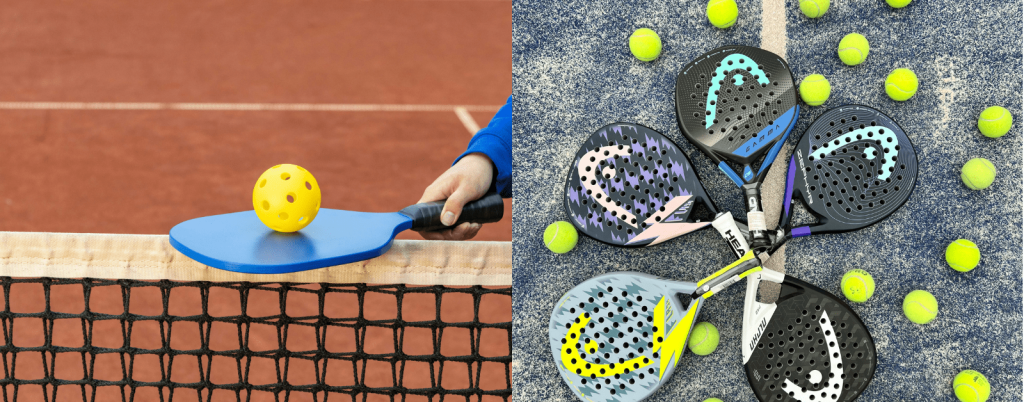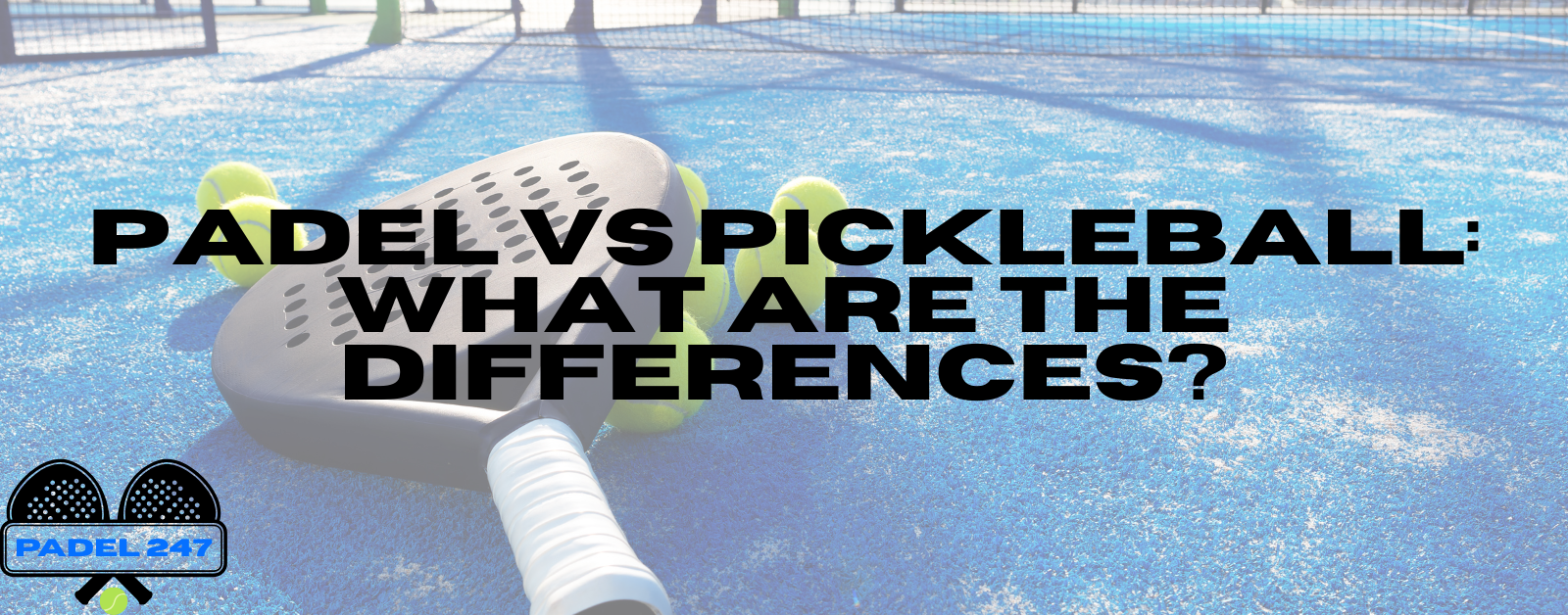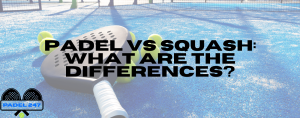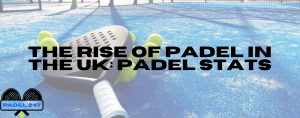Racket sports have seen a huge surge in popularity over the past decade, and two sports often catching attention are Padel and Pickleball.
While both involve rackets, a ball, and fast-paced gameplay, they are quite different in terms of equipment, rules, court design, and global popularity.
In this article, we’ll break down the key differences between Padel and Pickleball, helping you understand which sport might suit you best.
⚡ Quick Overview: Padel vs Pickleball
| Padel | Pickleball | |
|---|---|---|
| Court | Enclosed court with walls in play | Open court, no walls |
| Equipment | Solid racket with holes, pressurised tennis-like ball | Flat paddle, hollow plastic ball with holes |
| Scoring | Tennis-style (15, 30, 40, game, set) | Rally scoring to 11 points, win by 2 |
| Play Style | Fast-paced, wall rebounds, mostly doubles | Slower, strategic, focus on placement and dinks |
| Popularity | Huge in Spain & Europe, growing worldwide | Exploded in the USA, spreading globally |
| Best For | Players who enjoy movement & teamwork | Players of all ages, especially beginners & seniors |
Origins and Popularity of Padel & Pickleball
Padel originated in Mexico in the 1960s but became massively popular in Spain and Latin America. Today, it’s spreading across Europe, North America, and the Middle East, supported by professional circuits like the World Padel Tour.
Pickleball also started in the 1960s in the USA and has grown to become the fastest-growing sport in North America. It is now gaining international attention with increasing global participation and professional tournaments.
Courts and Playing Area
- Padel: Played on an enclosed court roughly the size of a doubles badminton court, with glass and mesh walls that can be used in play. Official dimensions for a Padel court are:
Length: 20 metresWidth: 10 metresTotal area: 200 square metres - Pickleball: Played on a smaller, open court of similar dimensions to badminton but without walls.
Visual comparisons make it clear: Padel uses walls strategically, while Pickleball is all about placement and reaction on an open court.
Equipment: Padel vs Pickleball Racket & Balls
- Padel: Uses a solid, perforated racket and a pressurised tennis-like ball.
- Pickleball: Uses a flat paddle and a lightweight plastic ball with holes.
The difference in equipment also drives differences in gameplay – Padel is more powerful and dynamic, while Pickleball is strategic and precise.

Rules & Scoring
- Padel: Follows traditional tennis scoring (15, 30, 40, game, set). Serves can be tennis-like but are generally underhand.
- Pickleball: Uses rally scoring, games to 11 points (win by 2). The serve is always underhand.
Key differences in scoring and serving make Pickleball easier for beginners to pick up, while Padel rewards familiarity with tennis-style play.
Playing Style & Strategy
Padel: Fast-paced, uses walls for rebounds, mostly played as doubles. Requires agility, movement, and teamwork.
Pickleball: Slower, emphasises placement, strategy, and dinking rallies. Played as singles or doubles.
Accessibility & Learning Curve
Pickleball is easier for beginners and less physically demanding, making it ideal for older players or those new to racket sports.
Padel demands more movement and fitness, appealing to those seeking a dynamic, high-energy game.
Popularity
Worldwide Popularity
Worldwide Padel Populairty
Padel has around 30 million players globally. The sport is particularly popular in Spain, with 5.5 million players, followed by Italy (1.5 million), Argentina (1.4 million), and Mexico (1 million). Worldwide, there are between 43,000 and 63,000 padel courts.
Worldwide Pickleball Populairty
Pickleball is experiencing explosive growth in the U.S., where participation increased from 4.8 million in 2021 to approximately 20 million in 2024. The global pickleball market was valued at £1.1 billion in 2023 and is projected to triple over the next decade. Internationally, the sport is expanding rapidly, with new tournaments and professional circuits emerging.
UK Popularity
Padel Populairty UK
Padel is growing quickly in the UK, with over 400,000 adults and juniors having played at least once in 2024. About 51,000 adults play at least twice a month. There are now 893 courts across 300 venues, and 43% of adults are aware of the sport, with around 8 million expressing interest in trying it.
Pickleball Populairty UK
Pickleball has around 35,000 active players in the UK. Membership has grown by 65% year-over-year, with 449 registered venues, marking a 58% increase compared to the previous year. Participation has surged during Wimbledon, and the sport is now officially recognized across the UK.
Padel vs Pickleball Cost
The cost of playing padel and pickleball varies depending on location and access to facilities.
Padel can be more expensive, as enclosed courts are costly to build and maintain. Court hire is often priced similarly to tennis, with costs ranging from £20–£40 per hour in the UK, depending on location. Equipment is also slightly more expensive: a quality padel racket can cost between £80 and £200, while balls are similar in price to tennis balls.
Pickleball, by contrast, is generally cheaper. Courts can be set up on existing badminton or tennis courts with minimal modification, keeping playing costs low. Equipment is affordable too, with decent paddles starting around £30–£50 and pickleball balls available for just a few pounds. For beginners, the lower barrier to entry makes pickleball more accessible.
Padel vs Pickleball for Beginners
When it comes to learning the game, pickleball is widely regarded as easier for beginners.
Pickleball has simple rules, a smaller court, and slower ball speed, which means new players can rally more quickly without feeling overwhelmed. The underhand serve is also straightforward, making the sport very beginner-friendly.
Padel, while still easier to learn than tennis, has a steeper learning curve because of the use of walls and faster gameplay. Beginners may need a few sessions to get comfortable with positioning, timing, and strategy. That said, once mastered, padel offers a dynamic, engaging game that appeals to players looking for a challenge.
Padel vs Pickleball Noise
One factor often overlooked when comparing the two sports is noise – something that has stirred debates in communities where new courts are built.
Padel generates some sound from players and ball impacts, especially against the glass walls, but it is generally considered less disruptive than pickleball. The noise is more muffled and contained within the enclosed court structure.
Pickleball, however, has faced criticism in many countries for being unusually loud. The hard plastic ball striking solid paddles produces a sharp “pop” that carries further than the sound of tennis or padel.
In fact, noise complaints have become common in residential areas near pickleball courts, sometimes leading to restrictions or disputes.
For those sensitive to sound – or for clubs based near housing – Padel may be the quieter option.
Padel vs Pickleball Fitness Benefits
Both padel and pickleball offer health and fitness benefits, but the intensity differs.
Padel is more physically demanding. The larger court, faster rallies, and use of walls require quick reactions, lunges, and bursts of running. It provides a good cardiovascular workout and helps improve agility, stamina, and coordination.
Pickleball, on the other hand, is less intense physically. The smaller court size reduces the amount of running, and the underhand serve keeps rallies accessible. While it still improves reflexes, balance, and mobility, it is better suited for older players, beginners, or those recovering from injury.
Padel vs Pickleball Court Availability
Where you can play is often just as important as how you play.
Pickleball has a significant advantage in terms of accessibility, especially in the U.S. Courts can be set up on existing badminton, tennis, or even basketball courts with minimal changes. This flexibility means it is easy to find a place to play in many regions.
Padel, however, requires purpose-built glass-walled courts. These are more expensive to construct and take up dedicated space. While Spain, Italy, and Argentina have thousands of courts, availability in the UK, U.S., and other countries is still catching up, making access more limited in many regions.
Padel vs Pickleball – Which Sport Should You Try
| Padel | Pickleball | |
|---|---|---|
| Why You’d Love It | Fast-paced rallies; walls add dynamics; social doubles; European popularity | Easy for beginners; suitable for all ages; strategic play; huge U.S. growth |
| Potential Drawbacks | Harder for beginners; need enclosed courts; more physically demanding | Smaller court & slower pace; rally scoring learning curve; limited UK availability |
Padel is ideal for players who enjoy fast-paced rallies, the added dynamics of walls, and social doubles play. Its popularity in Europe makes it especially appealing for those looking for a lively, energetic game. However, it can be harder for beginners to pick up, requires access to enclosed courts, and is more physically demanding.
Pickleball, on the other hand, is easy for beginners and suitable for players of all ages. The game focuses on strategic play rather than power, and it has seen huge growth in the U.S. Its drawbacks include a smaller court, a slower pace that may feel less intense for some, and limited availability in the UK.
Conclusion
While Padel and Pickleball may seem similar at first glance, they differ in equipment, court, scoring, play style, and accessibility.
- Padel is perfect for players who enjoy high-energy rallies and teamwork, especially on enclosed courts.
- Pickleball is ideal for beginners, older players, or anyone looking for a more strategic and social game.
Both sports are growing rapidly worldwide and in the UK, so the best way to know which suits you is to try both and see which you enjoy more.



